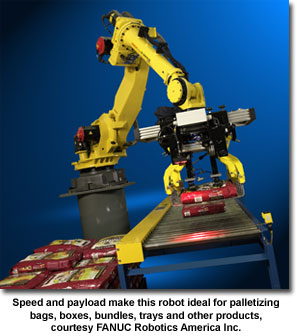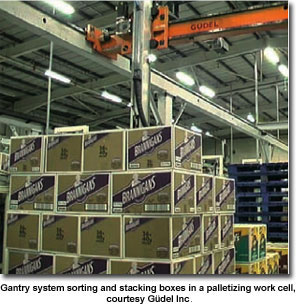Mixing it up: Trends in Packaging and Palletizing Robotics
Mixing it up: Trends in Packaging and Palletizing Robotics
by Bennett Brumson , Contributing Editor
Robotic Industries Association Posted 07/23/2008
The accelerating adoption of robotics has been among the most important trends in packaging and palletizing in recent years. With the speeds and flexibility that robotics offer, this trend will continue.
“Packaging and palletizing robotic applications are a growing industry. Just about everyone palletizes or packages their product,” says Kawasaki’s Bob Rochelle.
 “The cost of robotic technology has come down while performance and user-friendliness continues to improve in packaging and palletizing applications,” says Dick Motley, Account Manager for Distribution Network with FANUC Robotics America Inc., Rochester Hills, Michigan. “The trend towards the widespread adoption of robotics in packaging and palletizing applications is similar to what we have seen in the computer industry.”
“The cost of robotic technology has come down while performance and user-friendliness continues to improve in packaging and palletizing applications,” says Dick Motley, Account Manager for Distribution Network with FANUC Robotics America Inc., Rochester Hills, Michigan. “The trend towards the widespread adoption of robotics in packaging and palletizing applications is similar to what we have seen in the computer industry.”
Packaging Trends
“Recent trends in packaging applications have seen an acceleration in the use of robotics over hard automation,” says John Dulchinos, President and Chief Operating Officer, at Adept Technology Inc., Livermore, California. “I see a couple of high-level trends that will continue in the next several years.”
The first trend Dulchinos speaks of is the movement away from general-purpose robots towards robots designed with packaging applications in mind. “The trend towards application-specific robots is due to the combination of high speeds and relatively low payloads necessary in packaging applications. Robots for packaging applications deliver speeds and performance beyond what traditional articulated or SCARA robots can deliver,” Dulchinos says. Higher speeds are fundamentally compelling for increased throughput per square foot for each robot in a manufacturing facility, he maintains.
Dulchinos’ second trend is the role of vision systems in packaging work cells. “Vision is more highly integrated in packaging robots because randomly oriented product placement at high speeds requires vision and conveyor tracking. In addition, color vision is replacing gray scale.” Dulchinos also says vision can be taught to recognize products that vary in shape, such as many food products.
As for the packaging itself, robots are handling more blister packages, those pre-formed plastic wrappers used for packaging everything from small consumer goods to unit-dose packaging of pharmaceuticals. “The biggest trend I see is more blister packs,” observes JR Musselman, Software Engineering Manager at Doerfer Companies, Greenville, South Carolina. “End-users like blister packs because they are inexpensive and can be handled at very high speeds.”
Robots are often called on to package irregularly shaped items. Robert Rochelle, North America Sales Manager with Kawasaki Robotics (USA) Inc., Wixom, Michigan, describes such a project. “If a box is going to be stuffed with something irregularly shaped, like a lawn mower, we take data of its smallest to largest dimensions. We design the tooling and the pallet pattern to take into account the largest dimension.” Rochelle points out that by doing a little reverse engineering, work cells are integrated to get the result the end-user needs.
Bigger Pallets, Smaller Pallets
Robotic palletizing also has picked up a great deal in the last several years, according to Richard Tallian, Robotic Consumer Industry Segment Manager, ABB Inc., Auburn Hills, Michigan. “We are seeing a trend away from traditional palletizing work cells where a robot services up to four product in-feed stations and up to four outgoing pallets,” Tallian says. “The robotics industry is now seeing projects where a single robot is dedicated to a single end-of-line palletizing station. End-users are trying to avoid conventional material handling equipment.” Instead, end-users are putting robots at the end of the line to do complete palletizing operations, submits Tallian.
Tallian adds that larger end-users are driving a change towards smaller pallets that are used as displays in their stores. These pallets are assembled in a warehouse, trucked to the point of retail and put directly into stores. “Large retail stores are moving away from conventional pallets, which were traditionally loaded to heights over 86 inches. Now we are seeing more pallets loaded to 56 inches because the end-user wants these pallets placed directly into a store as end-of-aisle displays.”
 Likewise, Dick Motley of FANUC Robotics says large retailers are having an impact on robotic palletizing, saying, “Large distribution channels impose specific requirements on packaging and palletizing configurations, which demand versatility from the application. This has lead to a significant ramping up of packaging and palletizing robotics in the last few years and an acceleration of (the number of) manufacturers who purchase robots for packaging or palletizing applications.”
Likewise, Dick Motley of FANUC Robotics says large retailers are having an impact on robotic palletizing, saying, “Large distribution channels impose specific requirements on packaging and palletizing configurations, which demand versatility from the application. This has lead to a significant ramping up of packaging and palletizing robotics in the last few years and an acceleration of (the number of) manufacturers who purchase robots for packaging or palletizing applications.”
On the other end of the size scale, some end-users want robots to build larger pallets to maximize trucking efficiency. “The trend has been towards 110-inch high pallets, because that is what end-users can transport with by truck,” observes Brian Kocks, Sales Manager for Modules and Robotics, with Güdel Inc., Ann Arbor, Michigan. Loads are also getting heavier. “We are starting to see payloads going over the standard 100 kg.”
Dual-arm robots will become more commonplace in the coming years, predicts Tom Sipple, Handling Technology Leader at Motoman Inc., West Carrollton, Ohio. “Two arms allow for simultaneous operations, and facilitate handling of unwieldy objects like cases, trays or divider sheets. End-of-arm-tools can be simpler on dual-arm robots, which helps avoid interference and could allow for more flexible designs,” Sipple contends.
Company News

- When to Automate?
Systems integrators like S&R Robot Systems help in determining how automation of - S&R Robot Systems has Moved
It is an exciting day for S&R Robot Systems. We have moved - Is Your Goal to Improve Operations, How About a Robot Palletizing System?
Eliyahu Goldraratt in his book, The Goal, stated “Productivity is meaningless unless



